Palace of Versailles is a magnificent building located sixteen kilometers southwest of Paris in Versailles, formerly known as the residence of the French royal family. The arrival of the royal family in Versailles and the selection of this city as the site of the Palace of Versailles made the region famous; otherwise, it would have been equal in importance to other small towns in France in the past. The royal family’s arrival in this city in 1682 caused its development, and by the time of the French Revolution in 1789, Versailles, with a population of more than 60,000, had become one of the most significant urban centers in France. Here are the most important things you should know about the Palace of Versailles, presented by Lilimag :
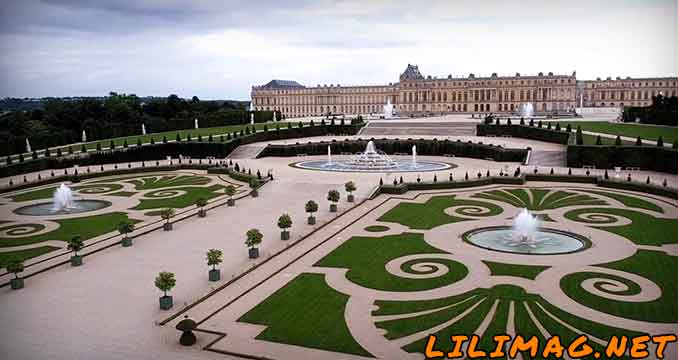
The Palace of Versailles (Château de Versailles, le Palais de Versailles, or Palace de Versailles) is one of the best things to do in Paris and France. This impressive palace has a total area of 8150256 square meters and has been named the largest royal territory in the world. The infrastructure area of The Palace of Versailles is equivalent to 67,002 square meters.
The magnificent architecture of the Palace of Versailles and its background and influence on French history and politics are two critical factors that have attracted the attention of ordinary people and historians around the world to this palace. Louise Boisen Schmidt is a Danish author who has done a lot of research on this palace and its background. He wrote about this palace: “According to popular belief, the Palace of Versailles is a prime example of the splendor of France. This palace represents an era in which France established itself as one of the world powers and unique. In addition, the bloody and influential events that led to the fall of the monarchy in France belong to this era. “
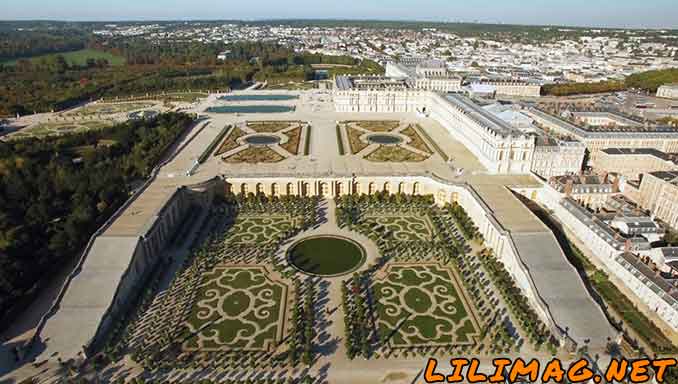
The Palace of Versailles History
In the beginning, it was the fertility of the lands of Versailles that attracted the attention of the French kings. Louis XIII (reign: 1643-1601) bought the land on which the Palace of Versailles was built, built a residence there, and occasionally went hunting there. At that time, most of the land around Versailles was uninhabited, which increased the number of wild animals in these areas, making it an ideal place for hunting. The residence ordered by Louis XIII was limited to a hunting lodge where the King and his entourage resided for a limited time. His successor, Louis XIV (1715-1638), nicknamed the King of the Sun, was the one who began the construction of this magnificent building and, near the time of his death, made Versailles the central meeting place of the French government. (The title of King of the Sun was given to Louis XIV because he believed that the proper way to lead the country was to use the central government, in which the King played a key role. He thought that the King was as important as the sun among the planets.)
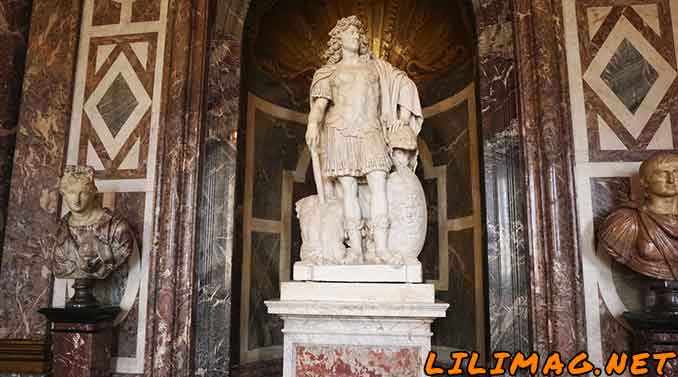
During the 72 years of his reign in France, Louis XIV expanded the hunting ground of the previous king, and by his order, a vast and beautiful palace was built, divided into two parts, south and north, and consisted of many buildings. The primary purpose of the Palace of Versailles was to show the power of the king. Tea Gudek Snajdar, a specialist and researcher in the history of art in Amsterdam, said: “The most important message that the Palace of Versailles, with its magnificent architecture, had for the people of France and the world, was the absolute power of Louis XIV as King of France. He believed in the king’s absolute rule and was so far removed from the common people that it was practically impossible to reach him. More importantly, Louis XIV was named King of the Sun, and one can see the influence of the architecture of the Palace of Versailles on the symbol of the Sun. The painter LeBron, who was responsible for designing the symbolic parts of the Palace of Versailles, focused his use of his paintings, sculptures, and architectural skills on one goal: to glorify the King of France.”
In addition to the buildings of the Palace of Versailles, several large and beautiful gardens were built in the western part of the palace, and specific design and shape were followed to make all the gardens (for example, one of the gardens were built in the form of a star). Sculptures and fountains were used to decorate the gardens, which pumped water upward using a hydraulic system. According to Gudek Snajdar, the purpose of building gardens was to show such beauty and grandeur that Louis XIV even dominates nature and enjoys such godly power.
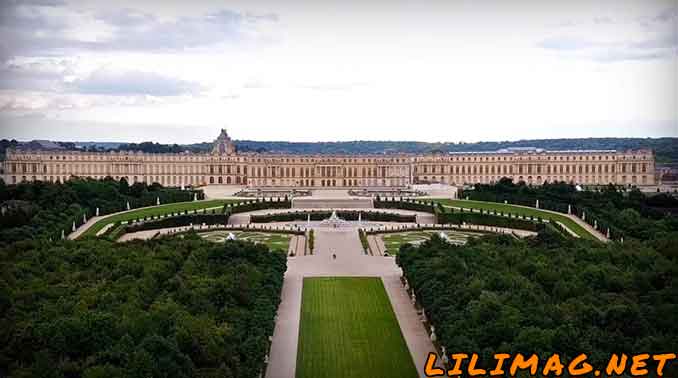
The gardens of the Palace of Versailles generally cover an area of 1976 hectares and are among the most extensive gardens globally. Annually 210,000 flowers and 200,000 trees are planted in these gardens. In 1979, these gardens were inscribed on the UNESCO World Heritage List next to the Palace of Versailles. The central palace gardens are more famous than other gardens. The beautiful geometric design of the garden, the rows of beautiful trees and sidewalks, and the ponds and water canals of this garden are among the reasons for its fame. Of course, more than anything else, the fountains in the garden of the Palace of Versailles attract attention. A total of 50 fountains have been built to entertain guests in these gardens, using 620 jets. Many of these fountains still use the same old hydraulic systems constructed by order of the royal family.
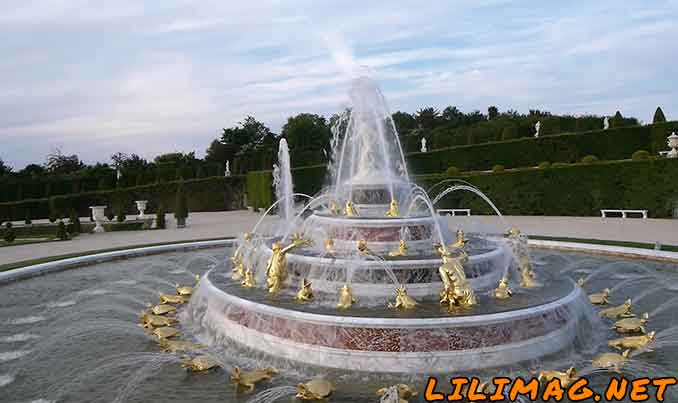
In the western part of the garden, a large water canal was built, approximately 1.6 km long, and was sometimes used to display French naval equipment. In addition, unique rowing boats were donated to France by the Venetian government in those years and were used in this canal.
The construction of this magnificent building was part of the plan and method of Louis XIV to express his belief in the rule of the monarchy, what is today called absolute government or pure authority. Louise Boisen Schmidt, a Denmark-based writer, said: “Louis XIV, as King of France, was the epitome of France, and the Palace of Versailles was built to showcase France’s power and wealth to the rest of the world. In addition, he had to strengthen France’s authority among other European nations, and this empowerment was not limited to the army and the military, and France had to show itself in the field of art. In France, for example, the import of mirrors from Italy was common at the time, but when the construction of the Hall of Mirrors of the Palace of Versailles began, all the mirrors needed were made by the French themselves and in their own country by order of Louis XIV.”
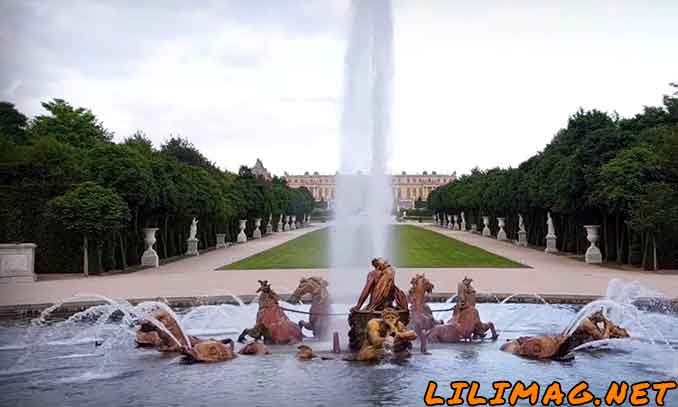
Another essential step of Louis XIV was the transfer of the center of government of France to Versailles. Historians believe that this action of the French king was due to two main reasons. First, in the event of a possible revolt of the people in Paris in the turbulent atmosphere of those days in France, it would be practically impossible for the rebels to reach the king. Another reason was that members of the French royal family and other courtiers and officials were forced to move to the Palace of Versailles to live. In this case, they were monitored, and the possibility of their disobedience was significantly reduced. Because of this action of Louis XIV, the court of the Palace of Versailles became the center of French political power for almost a hundred years (from 1682 to 1789). That is why today, the Palace of Versailles is not only known as a magnificent building. Alongside this, the Palace of Versailles is a symbol of the absolute power of the monarchy of those days in France. Finally, in 1789, during the events of the French Revolution, the Palace of Versailles was almost destroyed, and as a result, it lost much of its importance and influence.
After the French capital was moved to Versailles, and the king’s continued presence in the Palace of Versailles increased his interest in the building, he ordered the construction of the Grand Trianon Palace, which was a very luxurious palace, built 1.6 km northwest of the Palace of Versailles, and only Louis XIV and the guests of his choice could access it, and it was utterly exclusive.
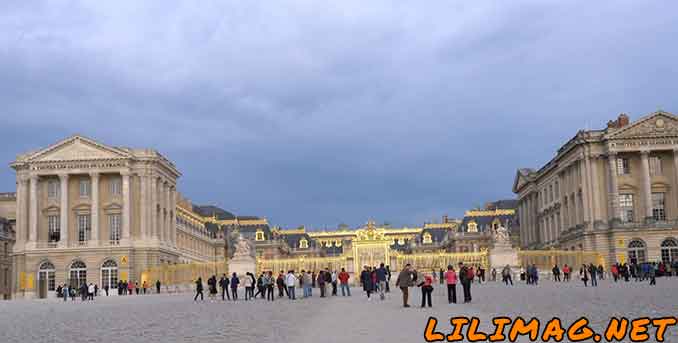
The Connection of American History with Palace of Versailles History
Two important and influential events in the American Revolution took place at the Palace of Versailles. Benjamin Franklin (one of the founders of the United States of America) went to the Palace of Versailles on behalf of the newly declared United States to negotiate a treaty between France and the United States with Louis XVI. Franklin was finally able to persuade Louis XVI to provide military support to the United States. At that time, by order of Louis XVI, one of Benjamin Franklin’s inventions, the Franklin chimney was installed in the Palace of Versailles instead of the old ducts, which produced less smoke than the old chimneys.
The signing of the Treaty of Paris was another significant event at the Palace of Versailles. The final agreement on the treaty was reached on September 3, 1783, at the State Department building near the Palace of Versailles, effectively ending the war with the revolutionaries. Decades later, when King Louis-Philippe I (1848-1830) converted the Palace of Versailles into a museum (ref), he painted a painting depicting the siege of Yorktown: the siege was hailed as a great victory in the Revolutionary War. In this war, the allied French and American forces destroyed the British forces.
The United States was still active in the palace in the 1920s: In those years, American millionaire John Davidson Rockefeller Jr., who had amassed considerable wealth from the extraction and sale of oil, rebuilt the roof of the Palace of Versailles and some other buildings.
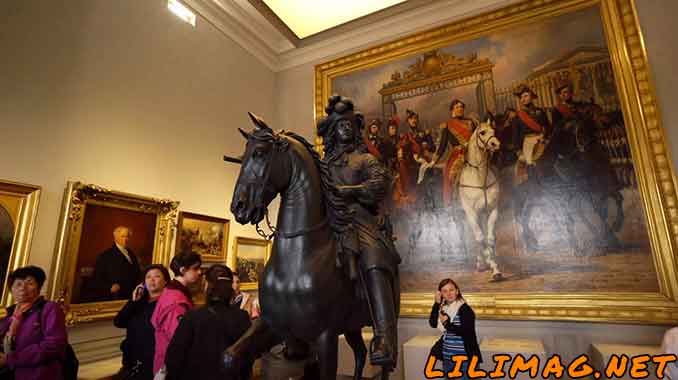
Palace of Versailles History After The Fall of The Kingdom
In 1789 the French Revolution reached its zenith, and Louis XVI and his Queen Marie Antoinette were overthrown. The revolutionaries brought them to Paris and beheaded both of them. After this incident, control of the Palace of Versailles officially fell to the new Republican government. Many of the palace belongings were sold during this period to cover the costs of future revolutionary wars. When Napoleon came to power in France, he ordered an entire apartment in the Grand Trianon and settled there.
By turning the Palace of Versailles into a museum, King Louis-Philippe I exhibited various aspects of French history. Today, there is a section in the museum of the Palace of Versailles called The Gallery of Battles, which houses artwork related to all the significant battles in French history between 496 AD (Battle of Tolbiac) and 1809 (Battle of Wagram; from the Napoleonic Wars).
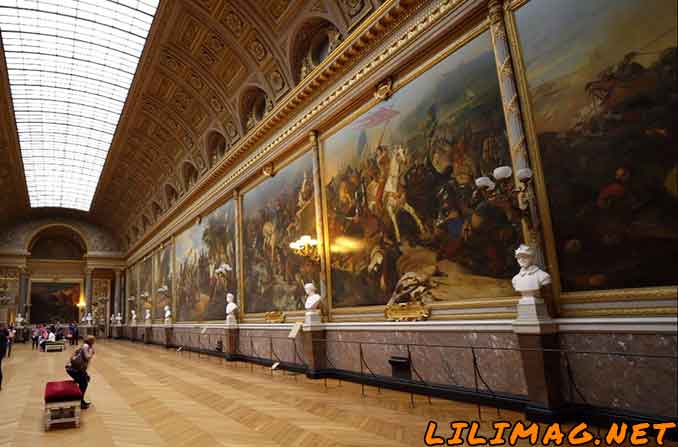
In the late nineteenth and early twentieth centuries, many parts of the museum were moved to the central interior of the Palace of Versailles to bring to life the pre-revolutionary atmosphere of France.
Two other significant events took place at the Palace of Versailles during this period. In 1871, France was defeated in a war with Prussia, and Wilhelm I held his coronation in the Hall of Mirrors of the Palace of Versailles to further humiliate the defeated French. Until a few years after the defeat, the situation in France was so bad that senators and other French officials were forced to hold meetings in Versailles instead of Paris (for security reasons).
In 1919, however, the French avenged this humiliation and defeat: In that year, the Treaty of Versailles was concluded in the Hall of Mirrors, requiring Germany to pay war reparations. Although the treaty effectively ended World War I, many believe it paved World War II.
Built initially solely as a hunting ground for the king and his entourage, the Palace of Versailles later became the site of some of the most critical events in human history: the events that shaped the world today as we know it.
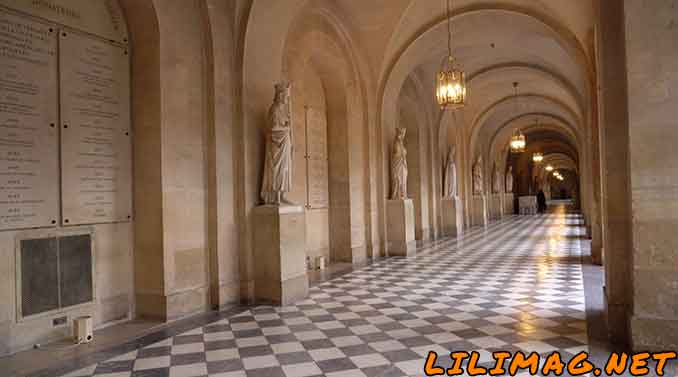
Today’s Palace of Versailles
Today, the Palace of Versailles is known as one of the most popular tourist destinations in France. More than four million people visit this historic site every year and are thrilled to see the magnificent architecture, beautiful fountains, and information about its historical background. Sometimes a concert is held in the gardens of this palace in summer.
If we consider the Palace of Versailles as a symbol of France, we will have two opposite aspects of the history and culture of this country: on the one hand, we will see the taste of French artists and architects and the richness of this country’s culture, and on the other hand, We will find out about its tumultuous history. When the construction of the Palace of Versailles was completed, it amazed (still excites) the world’s people and represented the power and greatness of France. Over time, however, in the late eighteenth century, the palace became a symbol of the wealth of the French aristocracy: a class whose lives differed markedly from those of the familiar people and the ordinary course of society. The beginning of the Enlightenment in Europe also completely changed the way of thinking of French culture, and since then, The Palace of Versailles has been seen as a symbol of the old tyrannical monarchy (more info).
For more about the Palace of Versailles history, from Louis XIII to the French Revolution, you can see the video below:
The following are the other interesting facts about Versailles Palace:
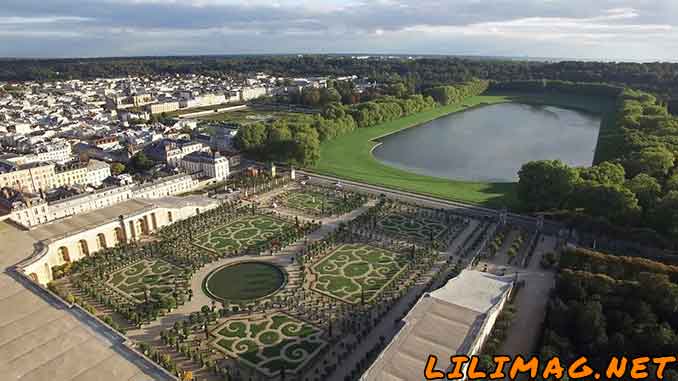
Interior of the Palace of Versailles
The Palace of Versailles consists of 350 residential units that vary in size and construction (from multi-room apartments to units about a royal). The area and geographical location where people were given to live depends on their position and the degree of their proximity to the king. For example, the king’s eldest son, the crown prince’s successor, owned a large apartment on the ground floor of the palace, but there was no better place for the palace’s staff than the attic.
Louis XIV’s bedroom is located on the upper floor in the center of the west-east axis of the Palace of Versailles. This room was known as the most important place in the interior of the Palace of Versailles, and the two most important ceremonies of that time, the awakening (sunrise) and the sleep (sunset) of the king, were held while some of the king’s maids of honor accompanied him. Louis XIV also had a special ceremony to wear and take off his hunting boots. As you may have noticed, these ceremonies were associated with the title of king, the king of the sun, which has already been described. The royal court was known as a minor example of the universe, and in the meantime, the king himself played the role of the sun of the universe. Everything the king did, was seen as a symbolic metaphor for his divine existence.
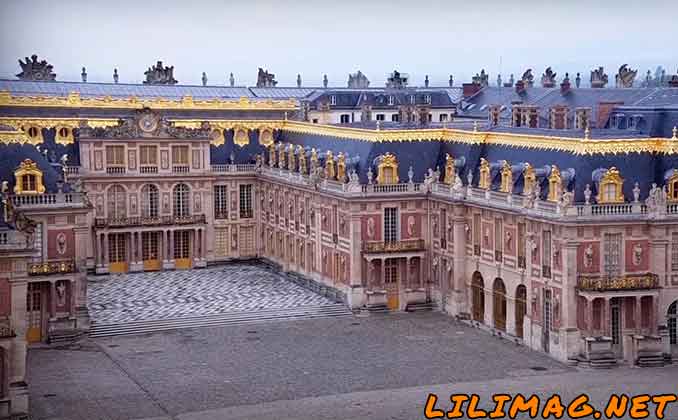
The importance of the presence of the king’s courtiers and successors continued during the reigns of Louis XV and XVI. A note from a courtier at the time, dated 1784, reads: “Most people who find their way to the court, eventually conclude that if they want to have a closer relationship with the king, they must be present everywhere. And, as far as possible, do not neglect to attend the sunrise, the boots, and the king’s sunset ceremonies. They must always be present at the royal dinner. In short, if they want to get the king’s attention, they must work tirelessly.”
The throne of Louis XIV was located in the Apollo Hall (Apollo, son of Zeus, known as the god of the sun, poetry, music, etc., in Greek mythology). The royal church was also intended for religious ceremonies, spanning two floors of the Palace of Versailles, and is believed by historians to have been built between 1699 and 1710.
For all the splendor of the Palace of Versailles, it was not possible to build a luxurious theater for a long time, and the king had to consent to the use of temporary halls. This trend continued until 1768, when the Royal Opera House was built by order of Louis XV. The design and mechanism of this hall were such that a place above the main stage was intended for musicians to allow dancing and banquet on the main stage. Of course, using the Opera House at night required 3,000 candles to provide lighting, and France’s not-so-good financial situation at the time made it virtually impossible to use the Opera House repeatedly.
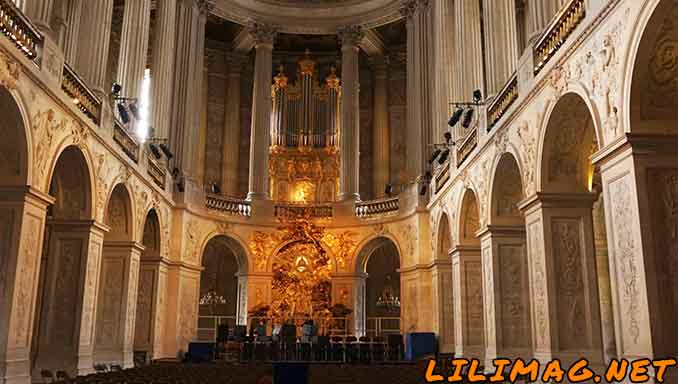
Palace of Versailles Hall of Mirrors
One of the most famous parts of the Versailles Palace is the Hall of Mirrors. This hall consists of 17 large mirrored arches, and in front of each of these arches, there is a window. In each turn, 21 mirrors have been used, and there are a total of 357 pieces of mirrors in the hall. The length, width, and height of the entrance of mirrors are equal to 73, 10.5, and 12.3 meters, respectively. Among the hall’s decorations, we can mention the ceiling paintings and gilded sculptures along the walls. Several glass chandeliers in the lobby are hung from the ceiling and have doubled their beauty. Some 20,000 candles were lit to illuminate the Hall of Mirrors at special royal ceremonies, giving it the nickname “Lighting Corridor.”
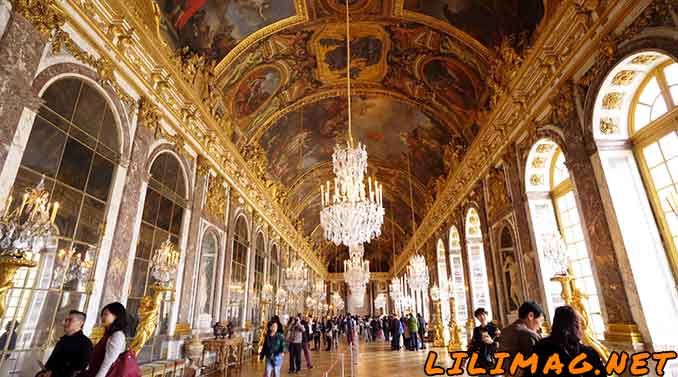
Palace of Versailles Churches
Five churches were built inside the Palace of Versailles, of which only the last remains. The church was consecrated as Louis IX of France during its construction and was initially dedicated to him (Louis IX was known as Saint Louis or St. Louis and was the patron saint of the Bourbon dynasty: the dynasty that ruled France and parts of Italy and Spain for centuries). The construction of this church was completed in 1710. Although the church is sometimes referred to as Baroque, its architecture is more limited than Italian Baroque churches and is more theatrical. The use of patterned and colored glass, the vaulted roof, and the narrow living room of this church have led some people to attribute the features of Gothic architecture to it (Gothic architecture was prevalent in Europe between the 12th and 16th centuries. Among the elements of this style of architecture, we can mention the pointed arches and windows and its tall columns.)
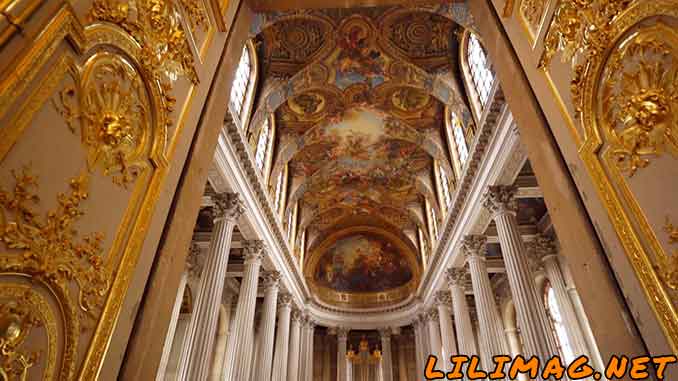
King’s Grand Apartments in Palace of Versailles
The next building is the King and Queen Grand Apartments, built in the 1670s by French architect Le Vau for Louis XIV. These apartments consist of several consecutive halls, each dedicated to one of the gods or planets. Court meetings were held in these halls.
The next building is the Queen’s apartments, consisting of several private rooms and the Queen’s golden bedroom. The bedroom had a secret door that the last pre-revolutionary French Queen and wife of Louis XVI, Marie Antoinette, used to escape the Paris revolutionaries (in the early days of the revolution).
You can see the other rooms of the Versailles in the below pictures:
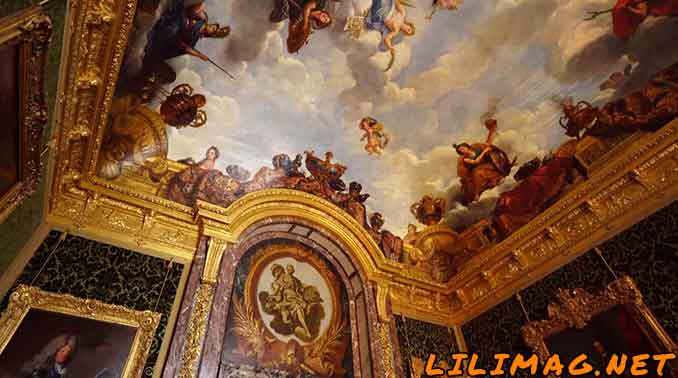
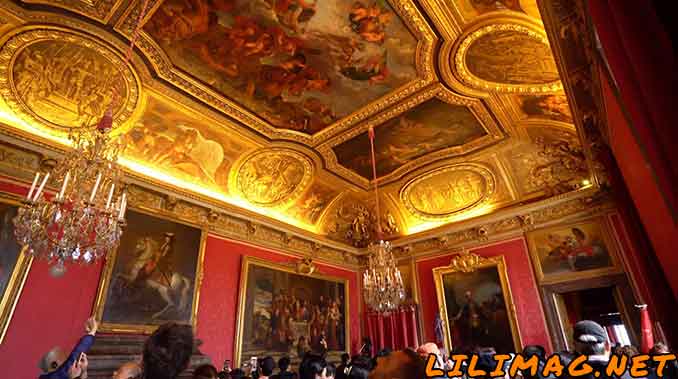
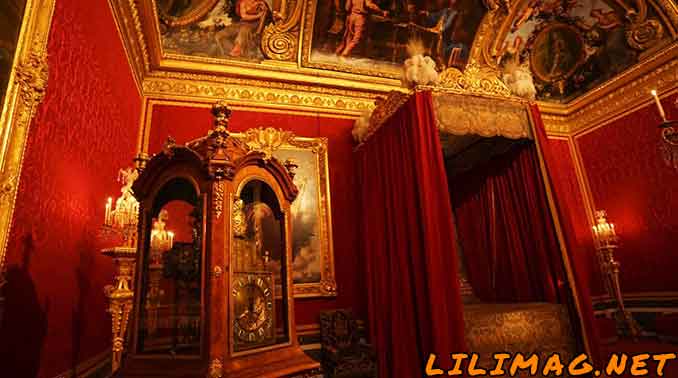
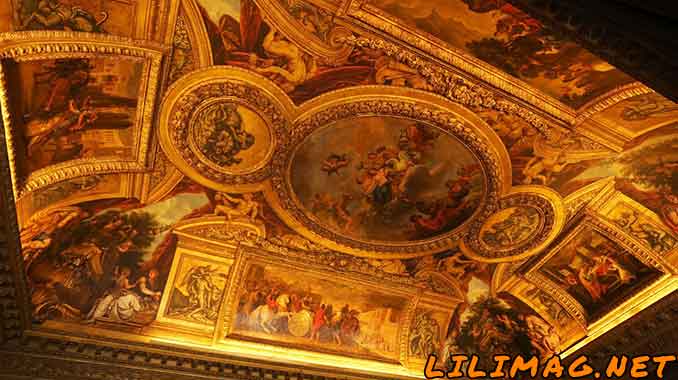

The Royal Opera in Palace of Versailles
The last building to be introduced in this article is the Royal Opera House of Versailles mentioned earlier. This hall was the main venue for theater and opera performances at the Palace of Versailles. The hall was designed by the French architect Ange-Jacques Gabriel, and for this reason, it is also known as the Gabriel Theater. The interior design of the gallery was done by Augustin Pajo, who made almost all parts of the interior with wood. The color chosen for the wood was such that it resembled marble. The hall is very suitable in terms of sound features, and most of this feature is due to the use of wood in interior design. The Royal Opera House of Versailles has a capacity of more than seven hundred people (more info).
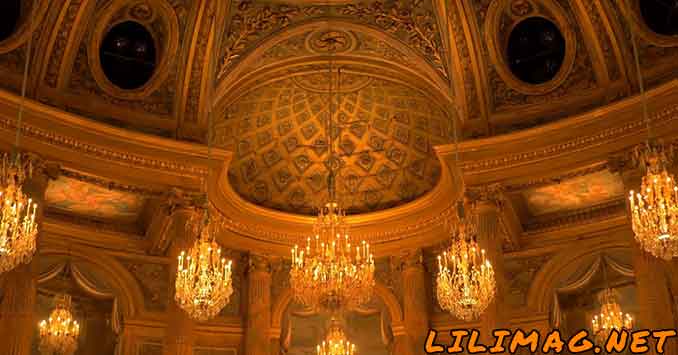
Art and Architecture of the Palace of Versailles
Today, almost any professional who visits the Palace of Versailles will find it the living example of Baroque and Rococo architectural styles (the late-Baroque or Rococo is an architectural style that was introduced in the mid-eighteenth century; This style is characterized by many decorations and details of the interior and its freshness and vitality). But the contemporary French at the time of the construction and operation of the Palace of Versailles did not consider its architecture to be Baroque, and this is quite understandable because the architecture of the Palace of Versailles is very different from the Italian Baroque buildings; Buildings that at the time were considered a source of inspiration for other European countries.
In fact, following the Italian Baroque style of construction of the Palace of Versailles could have angered Louis XIV: it contradicted his belief in the king’s absolute rule and that he was at the center of everything. To illustrate his point, Louis XIV fired the famous Italian architect hired to work on the Louvre (a palace built shortly before the Palace of Versailles).
Today, some historians consider the architecture of the Palaces of Versailles and the Louvre to be the style of classical French architecture. According to them, features such as symbols of power and eternal domination of the king that can be seen in the architecture of these two palaces distinguish them from the buildings of the Baroque era in Italy. Of course, the use of symbols could sometimes be seen in Baroque architecture, but it was rare for these symbols to emphasize the power of kings or the fact that God chose him to be king.
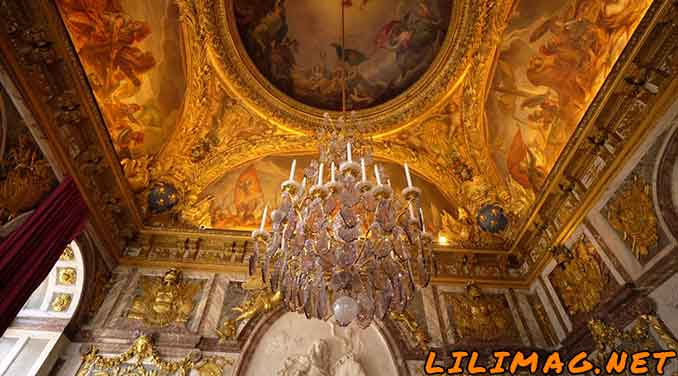
Almost everywhere we look at the Palace of Versailles, we find a symbolic meaning. For example, images of Roman Gods were used to decorate the ceilings, and in these images, Louis XIV played Apollo, the God of light or the sun. In addition, in place of the Palace of Versailles, one can see the initial letter of the king’s name, “L.” All this is to constantly remind us that he is the king and that the grace of God is the primary source of his power.
Another point that is used in the decoration of the Palace of Versailles and attracts attention is the emphasis on the king’s achievements. The story of the king’s life has been used to decorate the Hall of Mirrors and the adjacent Salons of “War and Peace.” For example, in the Hall of Mirrors, thirty paintings tell epic stories of the achievements of Louis XIV. In these narrations, particular emphasis is placed on the victory of the king in various battles. For example, one of the pictures shows Louis XIV crossing the Rhine River with his army in 1672; In this picture; Louis XIV is dressed in Roman clothes, his long hair is moving in the wind from behind, and he is holding a Thunderbolt that he wants to throw at his enemies (Thunderbolt is introduced as the weapon of the Zeus in Greek mythology). In this image, he is sitting like a god in his chariot, and the one who pushes his chariot is none other than Hercules, the son of Zeus.
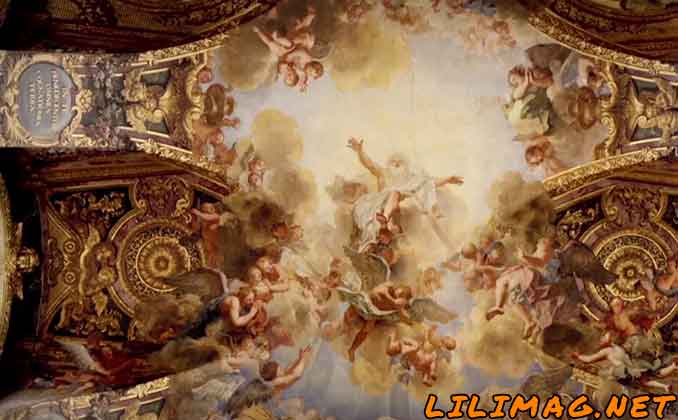
Estate of Marie Antoinette at the Palace of Versailles
Marie Antoinette, the wife of Louis XVI and the last queen before the French Revolution, ordered the construction of a separate estate near the Grand Trianon building at the Palace of Versailles, consisting of several buildings, a house, a small theater, and a farm (Fresh produce from this farm was used in the Palace of Versailles). The name Petit Trianon was chosen for this estate.
Marie Antoinette ordered the construction of another building, known as the “Temple of Love,” and she seems to have viewed the temple from his room in the Petit Trianon. The temple has a dome-shaped roof supported by twelve columns, and inside is a statue of Cupid, the Greek god of love, who is cutting his bow from the club of Hercules. Another building that Marie Antoinette ordered to be built in her estate was a beautiful cave with a moss bed for her to lie on and two entrances.
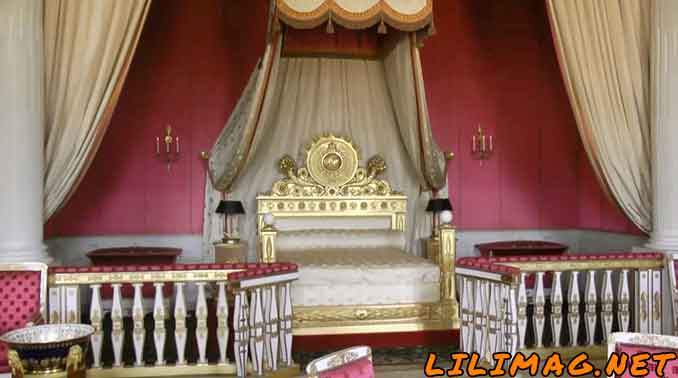
Although Marie Antoinette has been portrayed as an exaggerated and overly generous queen in history, she was not pleased to be queen. Paying more attention to the atmosphere of her estate, it can be seen that he wanted a simpler life and missed her native Austria. She was the youngest daughter of Francis I, Holy Roman Emperor (the Holy Roman Empire, which collapsed in 1806, was a vast empire including countries such as Germany and Austria) and his wife Maria Theresa, and grew up in Vienna, Austria. Marie Antoinette had a very normal childhood and adolescence, enjoying eating in her family’s privacy and even playing with ordinary children, but it was impossible to do so in the Palace of Versailles. Since becoming Queen of France, she has had less privacy and had to do almost everything in front of others. Being the Queen of France required Marie Antoinette to spend her dinner in a relatively large crowd, and special ceremonies were held for her dressing and some other work.
Marie Antoinette tried to change some of these tumultuous ceremonies during her reign but opposed the French and courtiers. For this reason, she built an estate in the Palace of Versailles to get rid of being under surveillance and exposure and to have her privacy. The construction of this estate was an attempt to relive the childhood that Marie Antoinette missed so much.
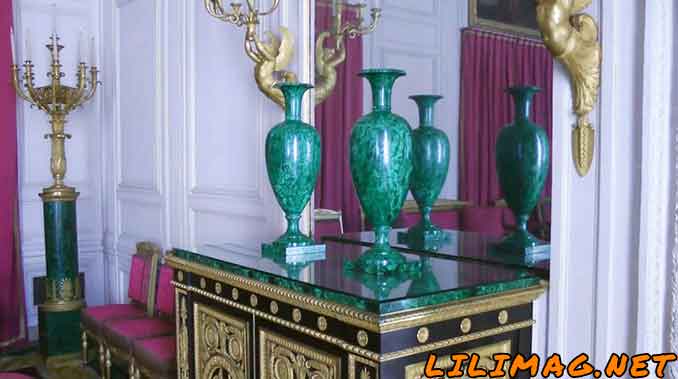
Palace of Versailles Facts
Here are the amazing facts about the Palace of Versailles:
- A total of 36,000 workers were used to build the Palace of Versailles and its gardens. The palace has a capacity of 5,000 people.
- The Palace of Versailles has 2153 windows, 1,200 fireplaces, 700 rooms, and more than 67 steps.
- Much of the furniture in the Palace of Versailles was either sold or transferred to other museums during the turmoil of the French Revolution. Later, during the reconstruction and restoration of the palace, many works of art were returned to the palace museum.
- Many valuable works of art and paintings were used to decorate the Palace of Versailles. It is estimated that the number of images used in the palace reached 6,000, and the number of other valuable furniture and equipment reached 5,000.
- Louis XIV devoted one-third of the total capital allocated to constructing the Palace of Versailles to its fountains.
- There are a total of 400 statues in the gardens of this palace.
- Hundreds of crew worked in the kitchen of the Palace of Versailles. However, the relatively long distance from the kitchen to the palace dining hall meant that most of the King’s food was cold.
- The actual cost of building the Palace of Versailles is an issue that historians are still debating and have yet to come up with a definitive answer, as the value of the currency of that time cannot be measured with certainty compared to today’s money. However, estimates have been made that the final cost of building the palace was between $ 2 billion (the US $ 1994) and a maximum of $ 299,520,000,000.
- In 2015, a film directed by Alan Rickman was released, which tells how the gardens of the Palace of Versailles were built. Kate Winslet is one of the famous actors in this film who plays the role of garden designer, and Alan Rickman himself has played the role of Louis XIV.
- When was the Palace of Versailles built? As mentioned before, Louis XIII decided to rebuild it in 1631, and construction continued until 1634.
- The Golden Gate of the Palace of Versailles was rebuilt in 2008. It was during the French Revolution that the gate of this palace was destroyed. Eighty meters of gold-plated steel rods and 100,000 gold leaves were used to reconstruct it. The reconstruction cost a total of € 5 million ($ 8 million) paid for by several charities.
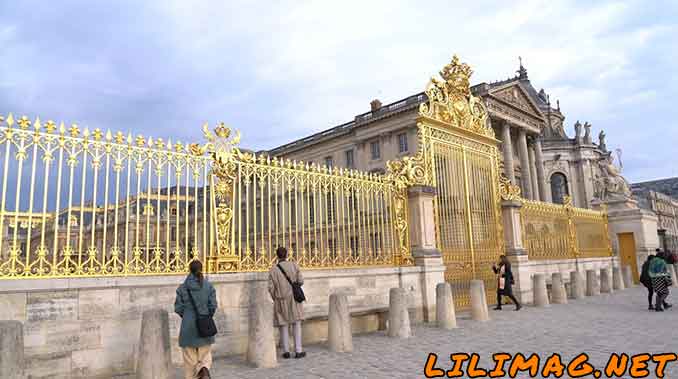
Practical Information about the Palace of Versailles
Here is the essential information about opening times and access of the Palace of Versailles:
Palace of Versailles Hours
The Palace of Versailles hours and opening times are as follows:
- The Palace: Every day from 9 AM to 6:30 PM (except on Mondays)
- The Petit Trianon: Every day from 12 PM to 6:30 PM (except on Mondays)
- The Gardens: Every day from 8 AM to 8:30 PM
- The Park: Every day from 7 AM to 8:30 PM
You should know that Saturdays and Sundays are the busiest days for visiting Versailles, and the Palace of Versailles closed on Monday. Usually, Wednesdays and Thursdays are the best days to see the Palace of Versailles. Also, you need between five to ten hours for visiting Versailles, including two to three hours for the palace, one hour for the gardens, and another two hours for the estate of Marie Antoinette, and two hours for transit time. For more information, click here.
Palace of Versailles Tickets
Ticket prices for the Palace of Versailles and surrounding attractions vary. This price difference depends on the type of visit, request for guidance, student age, and even the type of ticket. For example, access to the Palace and the estate of Trianon is free for visitors under 18 (or under 26 residing in the EU).
For more information, it is better to visit the official website of the Palace of Versailles (click here).
Palace of Versailles Location
Address: Place d’Armes, 78000 Versailles, France
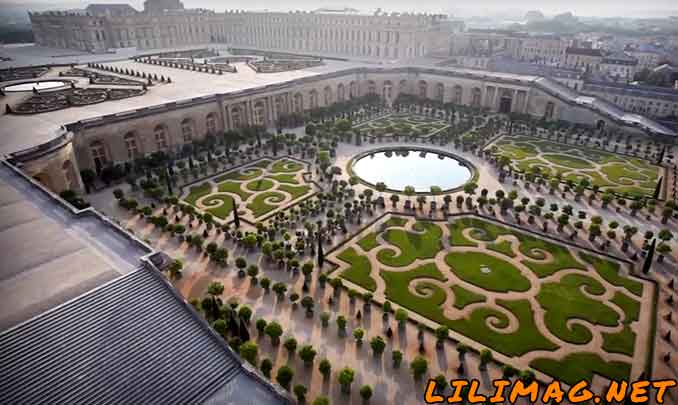
We suggest you watch the video below to learn more about the Palace of Versailles :
The Palace of Versailles is one of the best tourist attractions in France. This magnificent building, along with the Louvre Museum, the Eiffel Tower, and the Champs Elysees, is of great importance to Paris tourism. We suggest you visit this beautiful palace during your trip to Paris.
